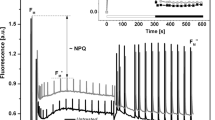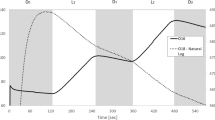Summary
-
1.
Nucleated, 1 cm long parts of the uninucleate green algaAcetabularia mediterranea form caps with shorter stalk lengths than do cells growing up from zygotes. This is due to the fact that these parts possess a maximum sized nucleus, which, as to the production of “morphogenetic” substances, has a higher activity than a small nucleus.
-
2.
If nucleated, 1 cm long parts are darkened for 14 days and then re-illuminated, cap formation happens at still shorter stalk lengths. This confirms that even if photosynthesis is suspended, the nucleus remains active and continues to release precursors of the morphogenetic substances or of a nuclear product leading to the synthesis of these substances within the cytoplasm (see the preceding paper).
-
3.
After treatment with Trypaflavin, the stalk is still more shortened. This means that the nucleus remains more active in Trypaflavin than in darkness. This finding is in agreement with the fact, that the size of the nucleus and nucleoli is reduced in darkness, but not in Trypaflavin. Probably in Trypaflavin the primary nuclear product released into the cytoplasm continues to be synthesized within the nucleus.
-
4.
In Dinitrophenol the building up of a store of morphogenetic substances cannot be observed. Thus more of the stalk must grow out before a cap is formed. This is apparently due to the strong effect of Dinitrophenol on energy metabolism.
-
5.
Cap formation takes place, if there is a sufficient level of active morphogenetic substances, but it is in wide limits independent of the mass of proteins and chloroplasts.
Similar content being viewed by others
Literatur
Beth, K.: Ein- und zweikernige Transplantate zwischenAcetabularia mediterranea undAcicularia Schenckii. Z. indukt. Abstamm.- u. Vererb.-Lehre81, 271 (1943).
: Experimentelle Untersuchungen über die Wirkung des Lichtes auf die Formbildung von kernhaltigen und kernlosenAcetabularia-Zellen. Z. Naturforsch.8b, 334 (1953).
: Beziehungen zwischen Wachstum und Formbildung in Abhängigkeit von Licht und Temperatur beiAcetabularia. Z. Naturforsch.10b, 267 (1955).
Hämmerling, J.: Über formbildende Substanzen beiAcetabularia mediterranea, ihre räumliche und zeitliche Verteilung und ihre Herkunft. Wilhelm Roux' Arch. Entwickl.-Mech. Org.131, 1 (1934a).
: Regenerationsversuche an kernhaltigen und kernlosen Zellteilen vonAcetabularia Wettsteinii. Biol. Zbl.54, 650 (1934b).
: Nucleus and Cytoplasm inAcetabularia. VIII. Congr. Internat. de Botanique, Paris. C. R. Séances et Rapp. et Communic. déposés lors du Congrès dans la Section10, 87 (1957).
: Über die wechselseitige Abhängigkeit von Zelle und Kern. Z. Naturforsch.13b, 440 (1958).
Hämmerling, J., H. Clauss, K. Keck, G. Richter andG. Werz: Growth and protein synthesis in nucleated and enucleated cells. Exp Cell Res. Suppl.6, 610–626 (1958).
Hämmerling, J., u.Ch. Hämmerling: Kernaktivität bei aufgehobener Photosynthese. Planta (Berl.)52, 516–527 (1959).
Hämmerling, J., u.H. Stich: Einbau und Ausbau von32P im Nucleolus (nebst Bemerkungen über intra- und extranucleare Proteinsynthese). Z. Naturforsch.11b, 158 (1956a).
: Abhängigkeit des32P-Einbaues in den Nucleolus vom Energiezustand des Cytoplasmas, sowie vorläufige Versuche über Kernwirkungen während der Abbauphase des Kernes. Z. Naturforsch.11b, 162 (1956b).
Holzer, H.: Photosynthese und Atmungskettenphosphorylierung. Z. Naturforsch.6b, 424 (1951).
Parnas, J. K.: Biochem. Z.274, 158 (1934). AusHinsberg-Lang, Medizinische Chemie, 2. Aufl. München u. Berlin: Urban & Schwarzenberg 1951.
Stich, H.: Experimentelle karyologische und cytochemische Untersuchungen anAcetabularia mediterranea. Ein Beitrag zur Beziehung zwischen Kerngröße und Eiweißsynthese. Z. Naturforsch.6b, 319 (1951).
: Änderungen von Kern und Polyphosphaten in Abhängigkeit von dem Energiegehalt des Cytoplasmas beiAcetabularia. Chromosoma (Berl.)7, 693 (1956).
Werz, G.: Die Wirkung von Trypaflavin auf Kern und Cytoplasma vonAcetabularia mediterranea. Z. Naturforsch.12b, 559 (1957).
Author information
Authors and Affiliations
Additional information
Mit 1 Textabbildung
Mit persönlicher und sachlicher Unterstützung durch die Deutsche Forschungsgemeinschaft.
Rights and permissions
About this article
Cite this article
Werz, G. Weitere Untersuchungen zum Problem der Kernaktivität bei gesenktem Zellstoffwechsel. Planta 52, 528–533 (1959). https://doi.org/10.1007/BF01914894
Received:
Issue Date:
DOI: https://doi.org/10.1007/BF01914894




